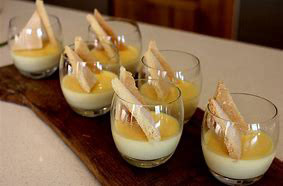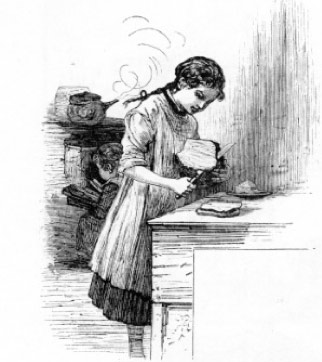A new dawn? The New York Times begins to recognize British foodways while its reporters engage in the timeless art of culinary innovation.
It is not that the Times never has published a British recipe nor discussed British food, but its coverage of British foodways historically has been curt and critical in the usual American manner. Various recipes for Scotch eggs or scones surface from time to time along with the occasional outlier, usually dessert--a marmalade cake or a fool. Over the last few months, however, things have changed (a little).
Since February, the Times has published a number of savory as well as sweet British recipes, from Melissa Clark, David Tanis and, the bigger surprise, Yotam Ottolenghi. An Israeli relocated to London, Ottolenghi is celebrated for his cooking and cookbooks. He operates six restaurants now and has lent his name, with co-authors, to seven cookbooks. His regular column for The Guardian generates an astonishing number of recipes.
2. Familiarity breeds respect.Ottolenghi arrived in Britain with the usual misperception of its foodways. As he notes in his typically engaging prose,
“ ….hearsay tends to stick, much like the idea that British food is inherently bland, stodgy and lacking in imagination. Alas, this perception is how so many outsiders came to get a kick out of thumping British food for a very long time and, to an extent, still do.”
The accomplished chef and author does not even try to exempt himself from the conventional outside wisdom. “I can’t pretend,” he admits,
“that I didn’t share this attitude once upon a time. When I arrived on this island more than two decades ago, I was primed to be thoroughly unimpressed.”
His attitude changed with his first assignment in an English kitchen, to make Yorkshire puddings for the Sunday roast. “It didn’t take long” after eating one “to be proven gloriously wrong.” Notwithstanding his broad and deep Mediterranean repertoire along with a more recent interest in Asian elements, Ottolenghi confesses to a fondness for English food. He likes to cook it at home. Given the decidedly non-English nature of his publications, that comes as no small surprise.
Ottolenghi in Spitalfields.
Ottolenghi remains infatuated with the Yorkshire pudding and its cousin, batter pudding or toad in the hole. It consists of “the three elements that turned” him “into a culinary Anglophile in the first place: well-cooked meat, crisp pancake and velvety gravy.”
The dish has come to be associated with sausage, but traditional toads might include any meat, game or poultry, alone or in combination. Hugh Fearnley-Whittingstall cooks his ‘flying toad in the hole’ with pheasant and sausage: Ottolenghi likes meatballs instead, “for their looser texture.” He claims they “are the only deviation from tradition I allow myself,” but does add some decidedly Italian balsamic vinegar to his gravy. Malt or cider vinegar would be more appropriate in terms of tradition but everyone may improvise. (“Greatness of British Cooking”)
In fact Ottolenghi very nearly always deviates from tradition with abandon. His website does include a few recipes of recognizably British derivation, but ever the maximalist, he juices all of them with extra ingredients, from the inevitable Mediterranean seasonings to the superfluous addition of oversweet whole wheat to his ‘Irish’ stew. But why not barley? If gilding the lily, mine the local ore.
The quotation marks around ‘Irish’ are Ottolenghi’s, but other than the additions of the wheat, white wine and, inadvisably, sugar, the stew is one of his less baroque renditions of a familiar preparation.
The great Theodora FitzGibbon did something similar, or used a similar descriptive, way back in 1952 when she described a “French Irish Stew.” In stark deviation from the norm however, her ego was not always at the wheel and she was not attempting to put her personal stamp on a classic. “The somewhat paradoxical title” of the dish, according to FitzGibbon,
“devolved from my father, who was Irish, trying to explain to a French restauranteur how to make an Irish stew. This is what we got instead.”
Perhaps the proprietor could not comprehend, or could not contemplate, what he considered the culinary heresy he had been asked to embrace.
In any event what the FitzGibbons got was not a stew but rather a whole lamb joint braised in stock on a bed of garlic, sliced onion and potato. “It was so good,” FitzGibbon recounts, “that we always used this recipe thereafter.” (FitzGibbon 63) If anything the French innovator managed to simplify an already simple preparation, displaying a disposition in contradistinction to Ottolenghi.
Incidentally FitzGibbon adds a uniquely British option to her version by suggesting Marmite dissolved in water instead of the stock, which adds a welcome layer of flavor to the dish. Either way it is an example of a creation that is even better than the sum of its good ingredients.
3. A proliferation of pies.Pies fire Ottolenghi’s imagination. “I love all pies equally,” he says; “I find their inbuilt comfort totally seductive.” That was not always his view. As with batter pudding, he invokes his former unfamiliarity with British foodways to explain his initial antipathy.
“In Britain,” he found, “the word ‘pie’ has multiple meanings, some old, some new, some sweet, some savory, some with a pastry crust, others without. To an outsider,” he explains,
“this is all very confusing. I can remember walking into a butcher shop in Edinburgh, more than 20 years ago, to buy an attractive-looking pork pie, wonderfully sculpted with a thick hot-water-crust pastry, only to learn, to my horror, that it needed to be eaten stone cold, so the jelly holding together the meat pieces remained properly set. I have since gotten used to such peculiarities, and have even learned to like them, but I still find British pie culture perplexing.”

Odd to Ottolenghi.
Ottolenghi is no Miesian piesmith. “For extra flavor,” he advises in nontraditional mode, “meaty pies benefit from the addition of spices, herbs and acidity, and lots of garlic.” As for fish pie, he is correct that “smokiness is key,” but instead of finnan haddock or smoked trout he uses bacon, fresh fish and shrimp. He also uses “aniseedy herbs, such as tarragon, dill and parsley,” although neither dill nor tarragon is characteristically British and parsley tastes nothing like anise. (“Savory Pie”)
Nor will Ottolenghi be packing up his pomegranate molasses, ras el hanout and Zat’ar. During the last few months some eighty of his recipes have appeared in the Times, placing the proportion of his Anglo-Mediterranean hybrids at just over two percent.
4. An Englishman near the kitchen.Clark is a beloved figure whose column and podcasts at the Times attract a fervent following for good reason. She comes across as kind, personable and smart, the kind of person whose conversation would be welcome over a few drinks or, better, some food and drink.
Clark by now has written almost forty cookbooks. Her website, FOOD52, is among the most visited on the internet. It lists 107 purportedly British recipes, many of them duplicates--many, many entries for ‘English muffins’--or recipes written by British cooks that have no connection with traditional British foodways. By contrast the site lists well over three thousand Italian recipes, nearly thirteen hundred Indian dishes, more than a thousand French preparations and 366 from the Caribbean.
The dearth of British recipes is another surprise because, in common with Ottolenghi, Clark likes to cook British food at home if not in her test kitchen. She wrote to a reader during September 2018 that “I cook British food often as my husband is English.” Why then not share the preference through her writing?
It is not as if the traditional British repertoire lacks breadth. To cite but two examples, Lizzie Boyd compiled some two thousand “domestic, regional and folk cookery recipes” for British Cookery (Boyd flyleaf); Glyn Hughes describes 3,355 traditional English dishes and provides recipes for over 2,500 of them with The Foods of England online and in print.
Nonetheless Clark has published only a couple of British recipes so far this year at the Times, for posset and for sausages baked with red cabbage, onion and potato. Notwithstanding her husband’s heritage, Clark had never heard of posset until sometime after the publication of Simple by Diana Henry in 2016. She was skeptical that the classic combination of cream and sweetened citrus could succeed, even though she notes that posset predates the Elizabethan era.
5. Too good to be true?“It sounded,” she thought, “too good and easy to be true.” In the event she decided to give “it a go, figuring that even if it didn’t set,” she would “at least end up with something sweetly sloshy…. ”
Instead, predictably enough for those familiar with the dish, her posset “was creamy and velvety,… but also ethereally light, with a bright, pure cream flavor that was just tangy enough.” So as Clark cheerfully admits, she “was wrong, and the recipe was right.” (“Custard Sheds a Few Layers”)

Disclosures from previous years, written at lengthy intervals, include Worcestershire butter, Scotch eggs and potted shrimp. Clark apparently does not consider authenticity a constraint on her style. She has a particular proclivity for garlic and adds it to just about anything savory, including the butter and the shrimp, which may or not drown the other elements of each preparation depending on your palate.
The recipe combining sausage and vegetables is both simple and spectacular, at once sneakily traditional in its seasoning and an improvement on traditional technique.
Whether or not Clark knows it, and she probably does not, the spicing for her sausage dish would have found favor in the British kitchen before the First World War. Caraway was a favorite spice for both savory and sweet dishes before the war interrupted imports. Coriander was and is used to spice a number of regional sausage varieties and had been a component of the eighteenth century palette. Rosemary grows wild in southern England the year round and as with New Orleanian cuisine thyme may be the most prevalent herb other than parsley in the traditional British repertoire.
Historically a cook would dump some sausages atop the onion atop the cabbage atop the onion atop the potatoes. Clark adds a simple step to boost the flavor of the dish, splitting the sausages and smearing the cut side with mustard. The intact side forms a barrel vault for the structure to “turn crisp and coppery:” “The cut surface,” Clark explains, “allows the pork [or maybe not; see below] juices to render out freely, seasoning all the vegetables underneath like an instant sauce.”
An additional innovation; a layer of Parmesan between the sausage and onion “for complexity and richness.”
Nor does Clark stand on British ceremony when it comes to her ingredients. She urges her reader to “make this with any kind of meaty sausages: spicy turkey or lamb, chicken or duck, classic pork bratwurst, chorizo or hot Italian links.” After all, she adds, “using what you’ve got is part of the appeal.” (“Succulent Sausages”)
In addition to varying the selection of sausage, any kind of cabbage would do, even Chinese cabbage, while Cheddar or another hard British cheese would be as evocative of the islands’ culinary tradition as the Parmesan, which has been imported to Britain steadily and in strength at least since the seventeenth century.
Whatever the variation on British practice, Clark’s base composition works, it is cheap and also foolproof. An exemplary recipe.
6. Mutatis mutandis: It was ever thus.Ottolenghi and Clark are not breaking a path when they approach the British recipe as if it were a jazz score. Just as English is a promiscuous language, permutations and transmutations historically have appeared in British culinary practice, a contrast to the codified and eventually static nature of haute cuisine.
The essential potato did not amount to much in Ireland before the eighteenth century and would not gain acceptance in England until the waning days of the Regency. The British in India created two distinctive cuisines under the Raj, curry and its offshoots, including kedgeree and mulligatawny, along with another, lesser known and nearly vanished hybrid. If curries and their cousins represent Anglicized Indian dishes, the second Raj canon prefigured Ottolenghi in grafting eastern ingredients onto western dishes. (Perkins 75)
This second category of Raj hybrids itself then evolved at speed. They not only “became part of the colonial cuisine” but also “continued to be adjusted and modified and were passed on to succeeding generations of colonial families.” (Leong-Salobir 135)
7. A space-time continuum.Colonel Arthur Robert Kenney-Herbert devotes most of the five hundred odd pages in his celebrated Culinary Jottings from Madras, which first was published in what then was Calcutta during 1885, to straightforward renditions of recognizably British or French standards. Its famous chapter, covering curries and mulligatawnies, covers a mere twenty nine pages.
Also lurking within Culinary Jottings ; that lost cuisine of Anglo-Indian dishes, a novel composite of compatible ingredients and technique. Kenney-Herbert was happy enough to anticipate that Indian cooks would add local seasonings to the food they prepared for him and his reader as a matter of course, whatever its cultural origin was western or eastern, and he was realistic enough to realize that ingredients readily available in Britain could be either scarce and expensive or nonexistent on the subcontinent.

Many of the recipes from Culinary Jottings reflect those realities. The acid sting of lime cuts the agreeable richness of beefsteak and oyster pie from a chapter with the understated title “A few nice Pies” which themselves were unknown to India before the British arrived.
Tamarind supplements the vinegar to souse a fish. The traditional, and by the later nineteenth century all too frequently disagreeable, British white sauce profits from its dash of curry powder or Worcestershire which, incidentally, originated in a failed British effort to replicate Indian flavors. This kind of thing also anticipates Ottolenghi by over a century, both souse and sauce exemplars of something like what Felipe Fernández-Armesto considers a ‘frontier cuisine of miscegenation.’
So are curry’s cousins in British India. Take as one example that steak and oyster pie, a creation Ottolenghi should in turn want to adapt once he knows about it. The pie is a creation very much Kenney-Herbert’s own, much more than a European recipe slightly distorted with tracings of eastern spice. The pie is robustly seasoned in an appealing and cosmopolitan if idiosyncratic way.
Kenney-Herbert adds his ’spiced pepper’ to the filling but the mixture hardly sounds ‘oriental.’ In fact it descends from something French and Kenney-Herbert considers it “an invaluable thing for a thousand dishes,” including “all stuffings and forcemeats, whether required for roast, boiled, or braised poultry; for the dainty galantine or the savoury pie…. ” (Kenney-Herbert 121)
Unlike so many of his forebears and peers, no plagiarizing for the scrupulous colonel;
8. A departure.“I have been very successful with one that I concocted from Gouffé, which I feel my duty to tell you of, and urge you to go and do likewise.” (Kenney-Herbert 121)
Historians and his own contemporaries have considered Gouffé the greatest French pâtissier of his time, but in fact he ranged farther than that. A prolific author, Gouffé published an English translation of his encyclopedic Le Livre de Cuisine as The Royal Cookery Book a quick two years after the original French edition appeared in 1867. The first recipe, of course, is for Pot-au-Feu, so important a French foundation that it commands its own chapter, the only single dish that does.
Gouffé’s range is all the more impressive because he includes a number of recognizably British recipes, not least in a short chapter on “Pottings and Pies.” Then as now that represents a profoundly cosmopolitan move for a French chef. He travels north for Scotch Broth and back south for the turtle soup associated so closely with eighteenth century London, although he does consider both recipes “much too substantial to come up to [his] standard of what a soup should be.” (Gouffe 253n) You can take the French person out of France but….
Bread sauce is another indisputably British intruder on Gouffe’s essentially French sensibility, as Mrs. Leyel--no culinary Anglophile--noted in 1925: “This is one of the sauces we make better in England than in France, for the French don’t have bread sauce at all--a great mistake on their part, for properly made it is excellent, not only with birds but with many kinds of fish.” (Leyel & Hartley 9)
 Bread, for bread sauce.
Bread, for bread sauce.
Mrs. Leyel is right, and might have pushed further, for a forgotten author has written that the whole point of roast chicken is bread sauce. Gouffé’s is not quite up to snuff: It is a mere mix of breadcrumb, milk and onion bereft of standard seasonings like clove and mace, and plucked from too short a simmer after ten minutes, but he deserves credit for including it at all.
Gouffé includes a handful of puddings too, both savory (but just one) and sweet, some English standards like cabinet and the quintessential plum. He includes a primitive curry, if one that relies on only an ounce of curry powder for an entire bird stewed in a lot of liquid. If Ottolenghi complicates his British cuisine, Gouffe simplified his in the manner of the FitzGibbons’ cook, but no matter: Gouffé’s “Curry of Chicken” is good in its decidedly French way.
So is his spiced pepper. It is not, however, the colonel’s. Despite his modesty, Kenney-Herbert only used Gouffé for a point of departure. The French mix combines bay, clove, marjoram, nutmeg, rosemary and thyme with two ‘peppers,’ black and cayenne. Counterintuitively enough, the Anglo-Indian colonel ‘concocted’ something milder with clove, marjoram, nutmeg, savory, the black pepper and, an Asian if not traditionally Subcontinental touch, ‘Nepaul,’ or Sichuan peppercorns. It may, at your discretion, include salt. It does not, to our knowledge, appear in pie recipes from British cookbooks of the time.
9. “Here is a really good recipe for a savoury pie.” (Kenney-Herbert 522)Now to the pie itself. To begin, “a really good gravy,” or stock, is “highly essential.” Kenney-Herbert’s departs from European tradition with its addition of lime peel and vinegar but alliterative seasonings of mace, mixed dried herbs, mushroom ketchup and Madeira are familiar enough. (Kenney-Herbert 288)
For the beef and oyster pie he adds the liquor from the oysters. He seasons each slice of sirloin with “a dusting of spiced pepper,” tops it with a slice of boiled bacon, rolls the pair into a cylinder and dusts it with more spiced pepper. (Kenney-Herbert 522) A layer of these goes into the bottom of a buttered dish but first, and always, “rub your pie-dish with a shallot, before packing it.” Sound advice. (Kenney-Herbert 287)
Onto the beef goes a layer of oysters; alternate meat and shellfish to fill the dish and top it with more spiced pepper and a good grating of lime zest before pouring through some stock “till it almost reaches the topmost layer;” no more or the crust will weep. Sometimes, but not always, scatter quarters of hardboiled egg atop the whole before closing it with crust. (Kenney-Herbert 292, 293, 522)
For any savory pie, including this one,
“minced cooked mushrooms, minced truffles, and minced olives (made from remnants you may have saved after an important day’s cooking) will come in most efficaciously. Finely chopped liver is a capital thing to shake over the crevices when building a pie, and little bits of chopped anchovy may be similarly used. Ham and tongue, either sliced, or grated, is [sic] welcome in every kind of ‘pasty,’ bacon is almost as effective, and sliced Bologna sausage a very good substitute.” (Kenney-Herbert 287)
Sound advice in each respect.
10. A detour from Madras to Manhattan via Morcambe Bay.Back in December of 2016, Clark tore a conceptual leaf from Culinary Jottings in a more or less successful effort to transform potted shrimp into something spicy. The traditional preparation is a good means of preserving without refrigeration something perishable by encasing it in clarified butter. The potting process does not only preserve its prisoners, it amplifies their flavor, whether of shrimp or beef or anything else.
Clark does not quite comprehend the components of classic potted shrimp. Other than the butter and shrimp, or prawns in Britain, mace and cayenne both inhabit the pot: Clark does not realize the cayenne is essential and thinks the superfluous anchovy, prevalent as it is in other traditional British dishes, is.
As usual with American attitudes to British foods, Clark figured that potted shrimp would be dowdy, a dish analogous to cod liver oil in its nutritional value and nasty flavor,
“the kind of thing a British vicar might offer when he stopped to call on a pair of elderly sisters for tea. Wholesome and nourishing, but not at all sexy.”

Fortunately for Clark she took the plunge to order potted shrimp at a London restaurant and her gamble “threw that idea on its head.” The shrimp she was served likely were the famous tiny brown briny ones from Morecambe Bay. Nothing similar exists in the United States. Undeterred, Clark substituted bigger American shrimp, chopping them small and adding some salt.
To make her hybrid pot, Clark adds that anchovy, celery seed, her inevitable dose of garlic, lemon zest, black pepper and fresh thyme. Once again Clark apparently is unaware of a constraint inherent in the traditional concept, for the addition of fresh foodstuffs would defeat the preservative purpose of potting, but then we need not worry too much about that today. In terms of flavor her version is good, making up in punch what it sacrifices in elegance, although the celery seed “inspired by lobster rolls” [?] does nothing for the dish. (“Butter and Shrimp”)
11. A comprehensive cuisine.Henrietta Hervey also harbors hybrids in Anglo-Indian Cookery at Home: A Short Treatise for Returned Exiles from 1895. From its title we can tell that ‘home’ refers not to the domestic kitchen itself but more generally to Great Britain, a common usage among Anglo-Indians living in the Raj, along with ‘back home’ or ‘at home.’
Understandably given her audience, Mrs. Hervey specifies British ingredients that did not exist in and around the Subcontinent. Her ‘tamarind fish’ recipe notes that “salmon or cod are the best for the purpose in this country” and proceeds to describe a traditional British souse, or fish preserved in vinegar, enlivened with Raj spice. She rehydrates dried tamarind in the vinegar and adds chilies, garlic and saffron or turmeric to the solution. (Hervey 7)
Her “‘English’ Pullow,” as its name indicates, is a self-conscious departure from ‘Indian’ pelaus. Unlike its ancestors, the pullow gets seasoned simply with allspice (Mrs. Hervey likes allspice the way Clark likes garlic). The rice is fried in ghee with the allspice and then simmered in stock for service with crisped onion, hardboiled egg, “lightly fried raisins” and sliced almond. (Hervey 21)
For dessert, the straight subjugation of an Indian ingredient, by now already available back home, to British technique; a mango fool (“The green fruit, I believe, is procurable at Whitely’s”). (Hervey 30)
As we should expect from its title, Taste of the Raj by Pat Chapman, published a century after Mrs. Hervey’s “little gem of a cookery book” explores much the same territory. (Burnett & Saberi 122)
Chapman’s tamarind fish, however, is no souse but rather chunks of fresh fish flash fried with chili, powdered coriander seed, garlic and ginger, then simmered in a little stock laced with the tamarind. As with the ancient British souses, it is a recipe for oilier fish like mackerel.
Chapman offers a brisk description of pish pash, which takes kedgeree, another Raj offshoot of something traditionally Indian, even further from its roots by converting it to a soup.
His ‘spicy shepherd’s pie,’ known to indigenous cooks as ‘essapad spy,’ could not contrast more with Collingham’s characterization of Raj cuisine as British dishes feebly ‘orientalised’ with a chili or some garlic. (Chapman 80) This happy marriage unites two (or three) cultures by replacing the traditional British filling with an Anglo-Indian curry of minced lamb before returning to British technique by baking the pie under its topping of mashed potato made colorful in a turn back to India by a scatter of chili instead of paprika.
Anglo-Indian beef olives provide another example of hybridization and also belong to the family of lost dishes described by Kenney-Herbert. Here is Chapman:
“Take some beaten lean steak, roll it around a tasty stuffing, and bake to cook [sic]. That’s a beef olive. Although they have faded from view today, beef olives have been around in Britain at least since medieval times. A recipe appears in the Harleian manuscripts , cookery books from AD 1429, using parsley, onion, marrow, egg yolk, ginger, and saffron.”
If this sounds similar to the Anglo-Indian idiom, it is. Chapman explains that his grandmother’s recipe for beef olives, “typical of the Raj, uses an onion, and bread stuffing, with bacon, ginger, garlic, fresh mint and coriander leaves.” (Chapman 140). Ottolenghi or, for that matter, Clark, might have created the same thing.
Like Leong-Salobir, but in more accessible prose, Chapman ascribes this kind of Anglo-Indian innovation to indigenous cooks. Like Collingham, however, he takes a rather anachronistic view of traditional English foodways as he also echoes Kenney-Herbert. “The bobajee (cook) wasn’t content with doing it the bland old English way. He always added spices.” (Chapman 80)
12. Living in America… or maybe Italy.To return to the Times , and to David Tanis, who posted “A Trifle of Great Importance” at his ‘City Kitchen’ column back in May; trifle is of great importance to the British table, a most characteristic dessert that Tanis apparently thought his readers would know little or nothing about. He therefore couched his description of it in Italian terms.
No matter; at least Tanis chose to highlight a British dish, or his modified version of one. He also highlights fools in the column, sneaking in the minimalist recipe. For that Tanis gets extra credit on the British part of the publicity exam.

He bases both his fool and his trifle on rhubarb, a good choice. It is a primal English ingredient for savory as well as sweet preparations. Preparing his fool, or any fool, is “just a matter of folding together cooked rhubarb,” or any fruit, “and lightly whipped cream.”
In common with his colleagues at the Times , who cannot bring themselves, quite, to embrace British foodways, Tanis has altered a template by adding some decidedly inauthentic elements and subtracting some traditional ones. Instead of Sherry or Port Tanis uses Campari and Cointreau; instead of custard, crème fraiche and mascarpone; instead of English sponge, Italian ladyfingers. It does not take a culinary detective to notice than none of the chosen ingredients is British. At least Tanis retains the brandy and some orange zest but that is all he preserves of traditional trifle.
The additions and subtractions render the Tanis “Easy Rhubarb Trifle” so problematic in terms of the real thing that it does not deserve the name. Tanis himself describes his dish as “somewhat like a tiramisu” and he is right. It is closer to tiramisu than to trifle. (Tanis)
Unlike the hybrid creations of his colleagues at the Times , Tanis has leached anything British out of his dish. At least, however he got the name of a British dish and the recipe for fool before his readers.
13. Plus ca change….Ten years ago at the launch of britishfoodinamerica our manifesto maintained that in the United States, in a culture that prizes authenticity, diversity and novelty, British food was not even conspicuous by its absence. British food did not then exist as a viable cuisine in the American popular imagination, although it was considered something unpleasant to avoid and had become the butt of incredulous jokes. Back then a columnist at The Los Angeles Times derided this entire project.
Nobody was cooking what they considered British food in America, although a smattering of regional cooks, notably in the south but also in New England and elsewhere, inadvertently or not had preserved some British traditions.
Little of significance has changed. The attitude of Ottolenghi upon his arrival in England remains prevalent in the United States. Although our archive includes by now hundreds of recipes, strangers scoff at the subject matter of the site and acquaintances continue to insist that the British canon is both miniscule and dull. That is why the same manifesto remains timely and still leads our front page.
Iconic publications like the Times and influential websites like FOOD52 continue to underrepresent British foodways in comparison to every other cuisine of any significance and even in comparison to a number of obscure ones.
As the efforts of innovators down the years from Colonel Kenney-Herbert, Mrs. Hervey, the FitzGibbons’ restauranteur, and FitzGibbon herself to Ottolenghi and Clark indicate, British cuisine is complex, adaptable and compelling. It is fun. It has made a comeback in its country of origin and, perhaps later than sooner, will return to the United States.
Five (or four; Tanis cannot really qualify) recipes in eighteen weeks may not sound like much, but when it comes to British food in America the boomlet at the Times , however modest it may appear, represents real improvement.
On we go.

Sources:
Lizzie Boyd (ed.), British Cookery: A complete guide to culinary practice in the British Isles (Woodstock NY 1979)
David Burnett & Helen Saberi, The Road to Vindaloo: Curry Cooks and Curry Books (Totnes, Devon 2008)
Pat Chapman, Taste of the Raj (London 1977)
Melissa Clark, “Butter and Shrimp Make Holiday Magic,” The New York Times (22 December 2016)
“Custard Sheds a Few Layers,” The New York Times (31 May 2019)
“Succulent Sausages, Golden Vegetables and a Single Pan,” The New York Times (22 February 2019)
Lizzie Collingham, Curry: A biography (London 2005)
Theodora FitzGibbon, Cosmopolitanism in an English Kitchen (London 1952)
Jules Gouffe, The Royal Cookery Book (London 1869)
Henrietta Hervey, Anglo-Indian Cookery at Home: A Short Treatise for Returned Exiles (London 1895), facsimile reprint in Two Anglo-Indian Cookery Books (Cambridge, England 2013)
Glyn Hughes, The Foods of England www.foodsofengland.co.uk (4 September 2018) and (Adlington, Lancs 2010)
Adam Jacques, “How we met: Sami Tamimi & Yotam Ottolenghi,” The Independent (6 October 2013)
Arthur Robert Kenney-Herbert (writing as ‘Wyvern’), Culinary Jottings for Madras (London 1895)
Cecilia Leong-Salobir, Food Culture in Colonial Asia: A Taste of Empire (London 2011)
C. F. Leyel & Olga Hartley, The Gentle Art of Cookery (London 1925)
Blake Perkins, “Another Anglo-Indian Cuisine: The Cousins of Curry, featuring ‘A few nice Pies,’” Petits Propos Culinaires 104 (December 2015) 74-83
“Imperial Ecstasies, or the cuisine of British India,”www.britishfoodinamerica.com No. 41 (Summer 2014)
David Tanis, “A Trifle of Great Importance,” The New York Times (24 May 2019)


